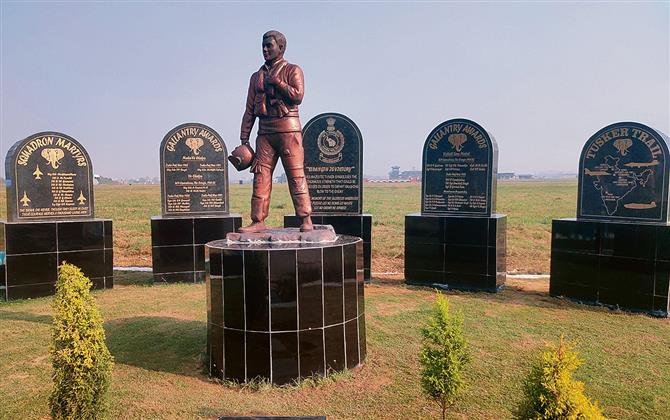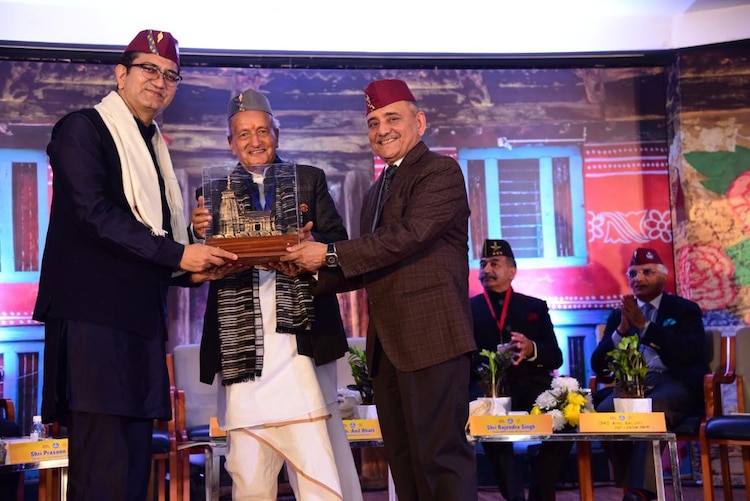
Bhartesh Singh Thakur
At dusk on December 3, 1971, the Pakistan Air Force (PAF) carried out pre-emptive airstrikes, and squadrons under the Central Air Command received instructions to retaliate. The war had started. At 2150 hours, the Canberra bombers of 5 Squadron went straight into the enemy skies for the retaliatory airstrike and struck Shorkot airfield.
The squadron left its mark in Congo, then in 1965 and 1971. During the Kargil war, we were in a deep strike role. We were the first to start GPS-based level bombing and then other units followed. We have a good legacy.
Air Chief Marshal Rakesh Kumar Singh Bhadauria (Retd). He commanded the Tuskers during the Kargil war
I am as old as the Air Force as I was also born in 1932. No. 5 Squadron is touching the sky with glory and respecting the sacrifice made by its officers.
Air Commodore KK Badhwar (Retd). He served 5 Squadron from 1965 to 1968 and carried out six missions in the 1965 war
It is a great squadron. I had a wonderful tenure. The squadron completed 10,000 hours of accident-free flying during those four years.
Air Vice Marshal Anil Golani (Retd). He served as Flight Commander from 1995 to 1999
5 Squadron is the best in the Air Force. I have told my boys that you are the best and they are yet to prove me wrong. Jaguars are ideal for low flying and weapon delivery is accurate. With upgradation, I would say it is kissing fourth-generation. We shouldn’t replace them in a hurry.
Air Marshal LK Malhotra (Retd). He had three tenures at 5 Squadron, including as CO
It was from Shorkot that the PAF aircraft had bombed Agra. “The enemy was caught unawares … the crew were delighted to find the runway lights on. The Tuskers wreaked havoc on this airfield,” says the official account of the squadron.
5 Squadron remained busy in the west, striking the enemy airfields and lines of communication in Chhamb, Shakargarh, Zafarwal, Chander and Risalewala, and other concentrations towards the south too. In one of its night-bombing missions, fuel and ammo dumps well inside the Chhamb sector were hit. As a result, the pressure on Indian troops was reduced drastically.
The squadron dropped about 36,000 LBS (Pound) bomb load on December 11 on enemy artillery and armour near Burejal and also struck the Mianwali runway. Sadly, it lost two aircraft and five Flight Lieutenants.
The Tuskers also took part in the air battles in the eastern sector and were among the few units with battle honours on both fronts in the 1971 war.
Wing Commander (later Group Captain) Man Mohan Bir Singh Talwar, who was commanding the squadron, was awarded the Maha Vir Chakra (MVC). He led five day-and-night bombing missions against heavily-defended enemy targets within the first 10 days of operations. “The bold leadership, tenacity of purpose, flying skill, and conspicuous gallantry displayed by Wing Commander Talwar were largely responsible for many a success of his squadron,” reads his MVC citation. Squadron Leaders RC Kohli and DC Bhandari, and Flight Lieutenant HP Singh were awarded the Vir Chakra (VrC).
Treasured legacy
5 Squadron was born from the remains of World War II aircraft. It was then the Royal Indian Air Force. To establish a heavy bombing feature, Hindustan Aeronautics Limited was asked to re-construct B-24 Liberators from the decaying remains of nearly 100 US Air Force bombers at Kanpur.
These aircraft, American-owned but British-operated, were wrecked and abandoned in India at the end of World War II. Despite the scepticism of the US and British advisers, the first six refurbished B-24s were ready by November 1948, and 5 Squadron was formed under Wing Commander JRS Dantra. It was the only four-engined aircraft being operated at the time.
Within months, the squadron was moved to Pune, which was to remain its base for the next eight years.
In 1957, the Tuskers, under Wing Commander (later Air Commodore) WR Dani, became the first to be re-equipped with the English Electric Canberra. It moved to Agra the same year.
The United Nations mission in Congo was the first for an IAF bomber squadron in UN operations. On October 5, 1961, the Tuskers carried out a long-range counter-air operation at a 1,300-km range at Katangan rebel airbase in Kolwezi. A Fouga Magister, two Dornier-28s, a Dakota, DC-4, and Dove got destroyed in the attack. Supported by European mercenary pilots, the attack had a demoralising effect on the rebels. Wing Commander (later Air Commodore) AIK Suares, VrC, led the operations under heavy firing, resulting in injuries to his navigator, Flight Lieutenant (later Air Vice Marshal) MM Takle.
For remarkable service in Congo, Wing Commander Suares was awarded a Bar to VrC. Flight Lieutenant Takle received the VrC, and Flight Lieutenant P Gautam the Vayu Sena Medal.
More glory was waiting for the squadron in the 1965 war. On the night of September 6 and 7, the Tuskers, commanded by Wing Commander (later Air Marshal) Prem Pal Singh, led the battle straight into the enemy’s heart and raided Sargodha. Wing Commander Prem Pal Singh personally flew six missions. A few days later, on the night of September 13 and 14, the squadron led by Senior Flight Commander Squadron Leader JC Verma surprised Pakistan as Peshawar air base, having B-57s and F-104s, was attacked. It was located close to the Afghan border and the enemy didn’t realise that the Indians would come that far. The Tuskers flew about 300 sorties during the war, mostly at night. Wing Commander Prem Pal Singh was awarded the Maha Vir Chakra.
The squadron lost an aircraft. Flight Lieutenant KK Kapur lost his life while Flight Lieutenant MM Lowe was taken as prisoner of war. He was repatriated in early 1966. Squadron Leaders SN Bansal and C Mehta, and Flight Lieutenants HS Mangat and PR Dastidar were awarded the Vir Chakra. Three Vishisht Seva Medals and 14 Mention-in-Dispatches were also awarded.
THE SWITCH
After operating Canberra for close to 25 years, the Tuskers were re-equipped with Jaguars in 1981. It shifted to Ambala under Wing Commander JS Sisodia, who rose to the rank of Air Vice Marshal.
It participated in Operation Pawan, the Indian Peace Keeping Force operation in Sri Lanka, in October 1987 and carried out reconnaissance missions. Wing Commander AK Singh, who later rose to the rank of Air Vice Marshal, led the squadron and received a Vayu Sena Medal in 1989.
Squadron No. 1 to 4 and 6 to 10 were raised before 1947, mostly during World War II, but not Squadron No. 5. That’s because Royal Air Force’s Squadron 5 was operating in India from 1920 until 1947 and a new squadron with the same number would have created confusion. Finally, when it was disbanded, Tuskers was raised in 1948.
“It has established an identity and track record that is in no danger of being confused with anyone else’s. They remain the only IAF combat unit to have served on another continent, after Independence,” says the official account of the squadron.
Tuskers became the first bomber squadron to receive the President’s Colours on April 9, 1975. Recently, 5 Squadron celebrated its platinum jubilee at Ambala.




















































































































